Vol 1 No. 20 TROPIC LIGHTNING NEWS July 15, 1966
Index
[The 1966 Vietnam issues of Tropic Lightning News were published in Saigon,
and are of lower quality than later years that were printed in Japan. Over
the years the photographs and text have faded and it has been difficult to
reproduce them. Even when the photos are unclear, I have been included
them to give a sense of the activities in the Division.]
June MEDCAP Treats 7,000
The division nearly doubled its civil affairs activities during the month of
June in a stepped-up campaign to increase Vietnamese-American friendship and
cooperation.
Patients treated under the Medical Civic Action Program (MEDCAP) jumped from
2,700 in May to almost 7,000 and the number of MEDCAPs increased from 50 to 95.
The division held more than 200 civil affairs projects in June.
Under the "Helping Hands" program, more than 6,000 Vietnamese received
clothing, food and toys. Toys have become increasingly popular as civic action
"ammunition" because of the large number of children attending civic action
projects.
The division continued its assistance to the Vietnamese 25th Division by
holding parties for its dependents and distributing "Helping Hands" items.
Major projects for the month included such road improvements as digging
drainage ditches, filling pot holes and widening roads around the division's
base camp. Other projects included providing fencing for school yards and
building several volleyball courts at local playgrounds.
"Tropic Lightning" troops donated $4,471 U.S. and 8,367$ VN to the Dong Ngai
Orphanage in III Corps during June. The drive continues this month.
A large number of leaflets were distributed, telling the people what the
division represents and why it is here. Others sought information about the VC
and still others asked the VC to surrender under the "Chieu Hoi" (open arms)
program.
Civil Affairs officers said their programs are meeting with increased
acceptance by the Vietnamese.
15 Sec Ambush Wipes Out Six, Captures One
A 17-man division ambush patrol late last week killed six Viet Cong and
captured one in a 15-second ambush west of Bao Trai.
According to one observer, the fire was so well coordinated "it sounded like
a Claymore mine going off." The Viet Cong, caught completely off guard. did not
fire a shot in return.
The U.S. patrol was moving toward an ambush position when the squad leader,
Sergeant Michael A. DiSantos, of Philadelphia, Pa., noticed four VC on a nearby
road. At the same time, the rear man in the patrol noticed five VC coming from
the other direction.
Quickly taking up positions parallel to the converging Viet Cong, the
division soldiers began a withering fire, which lasted about 15 seconds.
A search of the area disclosed six Viet Cong dead at the scene and one
wounded man, who was captured about 200 yards away.
One Thompson sub-machine gun, two M-1 rifles, and two U.S. carbines were
captured, in addition to small quantities of ammunition and grenades.
Early this week, Major General Fred C. Weyand, division commander, flew to the
scene and awarded Sgt. DiSantos the Bronze Star Medal with "V" device.
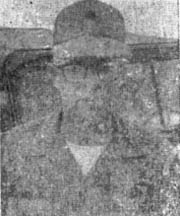 Lt. Col. North Becomes CO Of 4/23rd Inf.
Lt. Col. North Becomes CO Of 4/23rd Inf.
Lieutenant Colonel Louis J. North has become commanding officer of 4th
Battalion, 23rd Infantry, succeeding Lieutenant Colonel Michael Barszcz.
Col. North, who assumed command of the "Tomahawks" last week, was formerly in
the G-3 section at United States Army, Vietnam.
A San Francisco native, Col. North served from 1956 to 1959 as commanding
officer of the old Company K, 366th Infantry, in Alaska, former home of the
4/23rd.
A 1944 graduate of Officer Candidate School, Col. North was a platoon leader
during the last days of World War II.
During the Korean War, he served as a member of General Douglas MacArthur's
staff with the Far East Command in Tokyo.
In assuming command of the "Tomahawk" battalion, the colonel called it "...an
outstanding battalion. If I had a choice, I couldn't have picked a better
command."
Col. Barszcz has moved to 2nd Brigade headquarters to become brigade
executive officer.
Division Radio Begins Airing AFRS at 1330
"Tropic Lightning" radio is here, 1330 on your dial.
The program, now consisting of regular Armed Forces Radio Service (AFRS)
shows, will soon include half-flour local spots during its daily 24 hours of
operation.
Transmitter facilities are located in a radio van in the 125th Signal
Battalion area.
Local shows will consist primarily of command information, with tips about
rest and recuperation centers, news from units and their commanders and
chaplain's messages.
The radio station's 50-watt transmitter will prevent nighttime fade out from
the AFRS main station in Saigon.
The station will be staffed by broadcast specialists from the Division
Information Office.
1/35th Kills 62 NVA Troops
What started out as a routine day recently for the reconnaissance platoon,
1st Battalion, 35th Infantry, ended in a day of fierce encounters with the North
Vietnamese Army (NVA).
The battalion was operating in an area near the Ia Drang River, 40 miles
southwest of Pleiku. Various outposts had been set up through out the area of
operation.
One outpost spotted three to five North Vietnamese. After further
observation, the enemy was seen in increasing numbers.
A quick radio call brought in a barrage of 4.2mm mortars, followed by
artillery and air strikes.
Although the fire power had accounted for 15 dead, the enemy was so close to
the observation post that the balance of the recon platoon was called in to help
them withdraw.
Upon arriving, the platoon saw four enemy soldiers and decided to pursue
them.
They advanced 150 yards before being pinned down by a volley of small arms
and automatic weapons fire from an estimated battalion-size force.
Again artillery and air strikes were called, but the enemy force could not be
dislodged. Company A, less one platoon, was quickly brought in for
reinforcement.
Parts of Company C, with an attached platoon of Troop C, 3rd Squadron, 4th
Cavalry, advanced into the flank. They hit the enemy and fighting became so
intense that tanks were engaged at point-blank range.
Before additional units could be brought in to seal off the area, the NVA
broke contact and moved into the woods.
Sixty-two NVA were killed on the ground, plus an additional 15 killed by
air, for a total of 77. Nine automatic weapons, 27 small arms, four crew-served
weapons, anti-tank rocket launchers and 83 hand grenades were captured.
1st Fixed Wing Lands At Cu Chi Army Airfield
Another first has been added to Cu Chi's growing list.
The first fixed-wing aircraft arrived recently when Lieutenant Colonel Henry
A. Jones, of Shawnee, Okla., landed an O1E "Birddog" at the division base camp.
Col. Jones, the division's Air Force liaison officer, and Brigadier General
Edward H. deSaussure, assistant division commander, made delivery of the small
craft, the first to land at the Cu Chi airfield.
The Birddog is a small, one-engine, two-passenger plane used for aerial
observation.
In the near future, the division will be supplied by transport planes landing
at the airfield, another first.
|
Rising Sun |
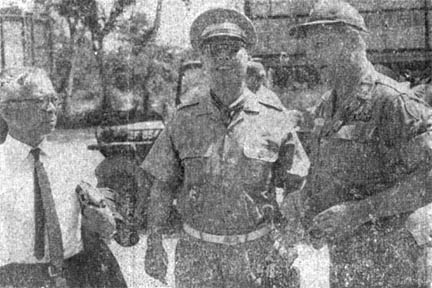 |
| AH SO DESU - Military Attaché Colonel Fujii (center), of the Japanese Embassy to South Vietnam, and Mr. Shishikuri, advisor to the Foreign Office of Japanese Ministry of Defense, are briefed on the "Helping Hand" program by Lieutenant Colonel Robert R. Hicks, civil affairs officer. The visitors were shown toys, clothing, food and other items that are distributed to Vietnamese villages. (Photo by Pardue) |
Page 2 TROPIC LIGHTNING NEWS July 15, 1966
Decorated
| BRONZE STAR MEDAL (Posthumously) | |
|
PFC Walter N. Ammons, Co. A, 1/5th Inf. PFC Charles E. Brooks, Co. A, 1/27th Inf. Sgt. Jesse J. Coffey, Co. A, 1/5th Inf. Pvt. Ronald W. Duckett, Co. A, 1/27th Inf. Sp4 Sydney J. Elyea, HHC, 1/5th Inf. Sp4 Allen Higginbotham, Co. B, 2/27th Inf. PFC Clifford T. Johnson, Co. B, 2/27th Inf. |
Sp4 Lamarr Phillips, Co. B, 1/5th Inf. SSgt. John E. Leer, Co. C, 1/5th Inf. PFC M. L. McCellen, Co. C, 1/27th Inf. Sgt. Arthur C. Morris, Co. C, 1/5th Inf. Sp4 Larry J. Nichols, HHC, 1/5th Inf. PFC Keith L. Shipp, HHC, 1/5th Inf. PFC James R. Taylor, Co. B, 1/5th Inf. |
| AIR MEDAL |
|
|
PFC Jeffrey L. Adams, Co. B, 25th Avn. Bn. SSgt. William E. Brown, HHC, 2nd Bde. Maj. Graham C. Davis, Co. A, 25th Avn. Bn. 1st Lt. James H. Flanagan, HH&S Btry., 25th Div. Arty. Maj. Cletus A. Hardin, Co. B, 25th Avn. Bn. SSgt. Edward L. Lanehart. HHC, 2nd Bde. |
Maj. James A. Lindberg, HH&S Btry., 25th Div. Arty. PFC Thomas A. Majerchin, Co. A, 25th Avn. Bn. Maj. Leslie K. Nakamura, HHC, 2nd Bde. Maj. Thomas D. Seay, HHD, 25th Avn. Bn. Capt. Paul M. Smith, Co. A, 25th Avn. Bn. Sp5 James A. Stevenson, HHC, 2nd Bde. |
| ARMY COMMENDATION MEDAL |
|
|
CWO Herman E. Cole, 25th Admin. Co. SSgi. William V. Magallones, Co. C, 4/9th Inf. SFC James Mattos Co. B, 65th Engr. Bn. Capt. Francis O. Nugent, HHC, 125th Sig. Bn. |
Capt. Jacob M. Romo, HQ & Co. A, 25th Med. Bn. 1st Lt. Frank D. Stone, 25th MP Co. SFC Ben F. Wallen, 7/11th Arty. |
| PURPLE HEART |
|
|
SSgt. Harvey Adams, Co. C, 4/23rd Inf. SSgt. Sakaria L. Auela, A Trp., 3/4 Cav. Capt. Gene E. Baxter, HH&S Btry., 1 /8th Arty. 1st Lt. Herbert A. Caddell, D Trp., 3/4 Cav. 1st Sgt. Richard I. Cambell, Co. A, 4/23rd Inf. 1st Lt. Richard M. Gohen, Co. C, 4/23rd Inf. Maj. William T. Crim, HHC, 4/23rd` Inf. Sgt. Curtis L. Foster, Co. C, 4/23rd Inf. |
Sp5 Robert J. Gessley, Co. A, 4/23rd Inf. Sp4 Victor S. Harris, Co. A, 2/27th Inf. Sp4 James D. Hash, HHC, 65th Engr. Bn. Sgt. Francisco Kawasaki Jr., B Btry., 1/8th Arty. SSgt. Michael J. Naughton, Co. A, 65th Engr. Bn. 2nd Lt. David B. Prince, Co. A, 2/ 27th Inf. Cpl. William L. Poe, Co. C, 4/23rd Inf. Sp5 Lloyd D. Sloan Jr., HHC, 4/23rd Inf. |
Why Some V.C. Quit
The nearly half million men and women who make up the civil and military
components of the Viet Cong army and its shadow government, the National
Liberation Front, are as diverse and divergent in origin and in motivation as
those of any army and government anywhere.
Perhaps the most important thing that sets them apart from their fellow
Vietnamese is the way in which they are incessantly told, and caused to repeat,
the reasons for everything they do, including supporting the Viet Cong.
The best illustration of their diversity and their common knowledge is found
in some of their own statements.
Consider the story of Captain Lam. One of the real "hard core," the backbone
of the movement, he took advantage of the government's Chieu Hoi program, which
welcomes the return to loyalty of former communist followers.
"I left my village in central Vietnam in 1947, when I was eighteen years old,
to join the Viet Minh. Two years later, because they said that all leaders in
the struggle against the French should, I joined the Communist Party. As its
political officer, I went North with my company in 1954, after the division of
the country."
"I lost my faith in the communist claim that we were fighting for the people
and decided that the only right thing was to join the forces of the Republic of
Vietnam ..."
By way of contrast, consider the words of Sergeant Vo An Long, a 31-year-old
squad leader in a main force battalion.
"I was a farmer until May 1960. The government controlled my village, but
the Viet Cong used to come at night and collect taxes. They would tell us - and
we believed them - that they were good men who loved and wanted to defend the
poor people like us, that they struggled and sacrificed even their lives to give
rights to the poor people.
"Finally, they told me and five other young men that if we stayed in the
village the government would take us away for the army, but that if we came with
them for a week of training we could become local guerrillas and defend our
village."
"I stayed with them for four years, fighting in many battles. Eventually I
could no longer stand being away from my family, and so I ran away and joined
the government side."
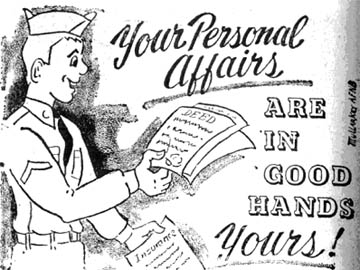 Editorial
Editorial
Wake Up And Be Alive
There is an old saying, "To be awake and alert is to be alive."
Today, the average person takes a big risk not only in crossing streets, in
the auto, home, etc., but also in his personal life. The world in which lie
lives is moving and moving fast.
Where do you fit into the picture? Are you awake and alert to all that's
going on around you? Are you on your toes?
For example, are your personal affairs tidy? If you should have an accident
tomorrow and land in a hospital (and who can assure you that you that you
won't?), do your dependents know where your records are located? Are they up to
date and the way YOU want them?
In this fast-moving world you must take into account every facet of living.
And that means right down to the smallest details.
The way you handle yourself and your personal affairs reflects upon you as an
individual. If your personal affairs are neat and tidy, as they should be,
good. You're awake and living. But just for safety's sake, check with the personnel people who handle your
records. They, too, are concerned with your personal affairs. But only you can
straighten them out. (AFNB)
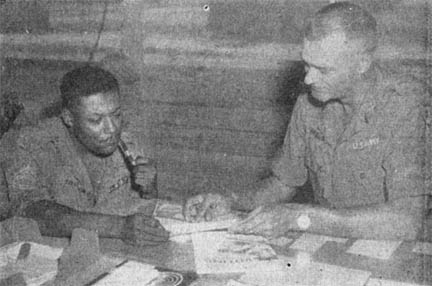 |
BALLOT - Captain Kenneth J. Schloesser, of South Saint Paul, Minn., adjutant of 3rd Squadron, 4th Cavalry, is also voting officer for his unit. Here he explains the 1966 absentee ballot form to Sergeant First Class Admiral W. Jefferson, of East Saint Louis, Ill., the squadron supply sergeant. Every division unit has a voting officer who is ready to help his men cast absentee ballots. (Photo by Pardue) |
| The TROPIC LIGHTNING NEWS is an
authorized publication of the 25th Infantry Division. It is published
weekly for all division units in the Republic of Vietnam by the
Information Office, 25th Infantry Division, APO U.S. Forces 96225.
Army News Features, Army Photo Features and Armed Forces Press Service
material are used. Views and opinions expressed are not necessarily
those of the Department of the Army. Printed in Saigon, Vietnam, by
Saigon Daily News. Maj. Gen. Fred C. Weyand . . . . Commanding General Maj. William C. Shepard . . . . . . Information Officer 1st Lt. William H. Seely III . . . . Officer-in-Charge Sp5 Dale P. Kemery . . . . . . . . . Editor PFC David L. Kleinberg . . . . . . Editorial Assistant |
Page 3 TROPIC LIGHTNING NEWS July 15, 1966
Fair Ends 'Santa Fe'; Bellyache, Anyone?
1/27th Throws Party For An Hoc Hoa
The 1st Battalion, 27th infantry, has ended Operation "Santa Fe" six miles southwest of Cu Chi.
Santa Fe," an area pacification operation, consisted of civic action
programs, road construction, "Helping Hand" operations and the construction of
an Army, Republic of Vietnam (ARVN), compound.
While on the month-long operation, the "Wolfhounds" accounted for four Viet
Cong dead, 21 captured and 82 suspects detained. Also confiscated were booby
traps, mines, hand grenades, a small number of weapons, assorted medical
supplies and 25 sampans.
Thousands of psychological warfare leaflets were dropped and broadcasts were
made from an ARVN public address truck.
On July 2, the "Wolfhounds" held a "county fair" for the villagers of An Hoc
Hoa, a short distance from their command post.
The "fair" consisted of music from the 2nd Brigade band, a Vietnamese
cultural show with singing and dancing entertainers, a dinner and "Helping Hand"
distribution of toys, clothing, and household items.
A Medical Civic Action Program visit was also conducted at the fair. The
Wolfhound medics treated the villagers, bringing the number of Vietnamese
treated on the operation by American doctors and ARVN aid men to almost 1,500.
The battalion civil affairs officer, Captain Kazuo Koike of Maui, Hawaii,
said the results were "very Pleasing."
"When we left, the people were not afraid of us the way they were when we
first arrived," the captain said. "They were willing to give information, and
the children were showing the men where they would find VC booby traps and 'dud'
mortar rounds.)
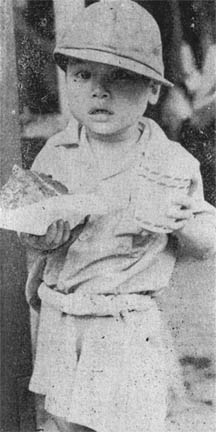 |
"Looka the size of this cake and this cup. Doncha think at's a pretty dumb question?" |
| "Yeah ! Yeah ! Yeah !" (Photos by Pardue) |
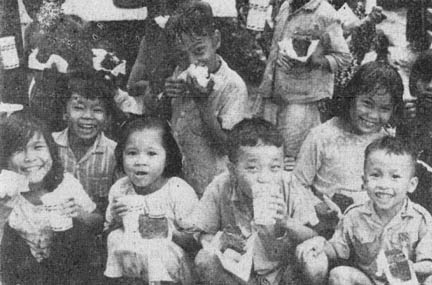 |
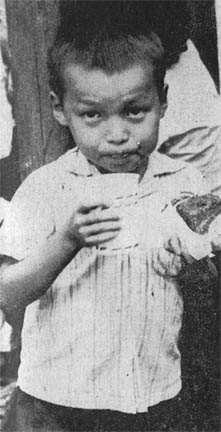 |
"I dunno, but I'm working on it." |
| "Who cares, with this big hunk of man (1st Sergeant Arthur H. Hand) around?" |
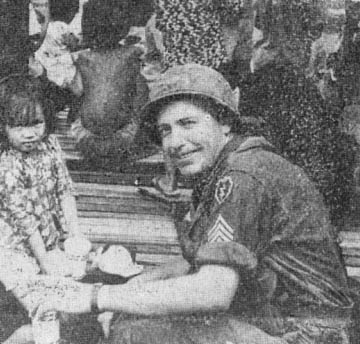 |
1/27th's 'Homesteader'
Seldom in the Army does an assignment with one unit last more than two
years. On rare occasions a man may stay in the same place three years.
Occasionally, however, there is that odd case of "homesteading" that shows
up. Such is the case with Captain Milton S. Goo, of Honolulu.
For nearly five years, Capt. Goo has been assigned in one capacity or another
to the "Wolfhounds."
But his is not even the usual case of homesteading - Army vernacular for
staying in the same place a long time. Capt. Goo has been assigned to the 1st
Battalion, 27th Infantry, since 1961; but, far from being stationary, he has
served the battalion in Hawaii, Okinawa, two tours in Thailand and now in
Vietnam.
He's held such jobs as communications platoon leader, company executive
officer, communications officer, assistant operations officer and company
commander. He is now the battalion adjutant.
"You'd think that being with a unit a long time would be advantageous," the
captain said, "but it isn't. After two years, commanders are hesitant about giving
you new missions because they think you're getting short."
But it seems that Capt. Goo never got short and never came close to leaving
the Wolfhounds until his Vietnam tour with the unit began.
It was only then that he realized that leaving the 1/27th was a near
certainty, since the tour of duty in the combat zone is one year. But, the
captain insists, he won't be really certain until he has orders in his hands.
"Then," he said, "I'll be short."
Page 4 - 5 TROPIC LIGHTNING NEWS July 15, 1966
[This issue of Tropic Lightning News was scanned from a bound library volume provided by the 25th Infantry Division Museum. Portions of the photographs and stories on pages 4 and 5 are missing. They were printed across the center of the 2-page-wide sheet and were hidden from sight because of the way the paper is bound into the book - the book could not be safely opened far enough to see that part of the page.]
25th MP Company
Of The Troops . . .
For The Troops
Military police - "Of the Troops...For the Troops" - peacetime's guardian and
wartime's protectors. And it is the image of the 25th Military Police Company
that greets and bids good-bye to each visitor at Cu Chi.
One of the prime responsibilities of the MPs is the security of the base camp
gates. All vehicles passing through these entrances must be checked carefully,
with each vehicle being logged to make sure that the vehicles and drivers have
authority to leave the post.
Civilian vehicles on the other hand, must be thoroughly searched and their
occupants screened before entry.
Another major role that the MPs play in the division's activities is the
support they give the various brigades which participate in the division's
combat activities.
They are responsible for screening the more than 1,000 Vietnamese workers who
are employed daily within the base camp.
At home, at Cu Chi, the MPs are responsible for the security and the
detention of prisoners of war at the POW collection point.
At the nearby village of Tan An Hoi, the MPs provide security for division
troops and also help the Vietnamese National Police maintaining order in the
village.
When the division is on operations, the MPs provide the same security for the
command post as they do when the division is "at home."
One of their more pleasant tasks is yet to come . . . providing security for
Red Cross "donut dollies," who will soon join the 25th.
These are but a few of the jobs the MPs perform 24 hours daily, jobs done
with a company of 189 men.
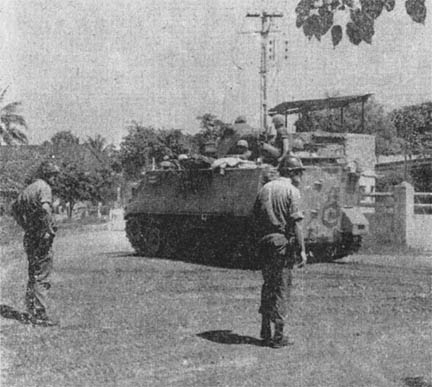 |
PFC James C. Schmuck, of Dover, Pa., searches a civilian vehicle at the main entrance of the Cu Chi base camp. |
| PFC Dennis Storch, of Bronx, N.Y., screens occupants of a civilian vehicle entering the main gate of the Cu Chi base camp. An unidentified Army, Republic of Vietnam soldier looks on. |
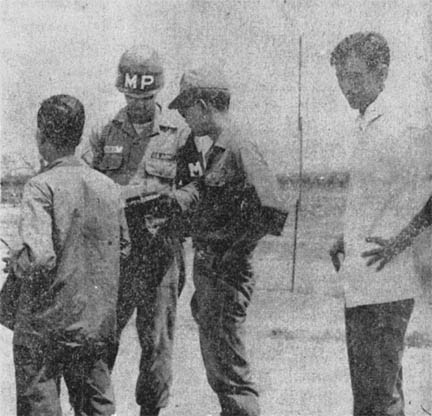 |
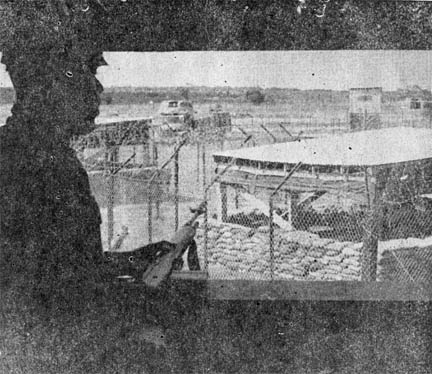 |
PFC Harry L. White, of Baltimore, stands guard at the prisoner of war collection point. |
| Whether the case calls for a helping hand or a firm stand, the Military Police Company usually provides it. Such is the case where Specialist Four William Rivera, of Denver, Colo., is concerned. He is shown here helping one of the Vietnamese workers to her feet. Rivera and Specialist Four Wilkie Saylor, of Stoney Fork, Ky., are guarding the workers as they check in for their jobs at division. |
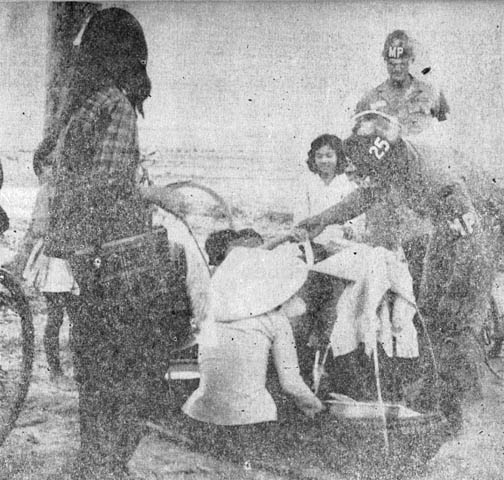 |
Page 6 TROPIC LIGHTNING NEWS July 15, 1966
How To Knock Out V.C. Tunnel System
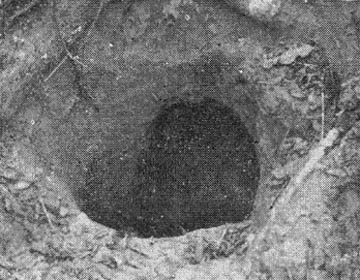 |
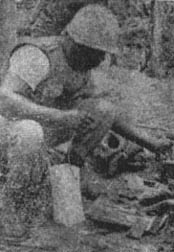 |
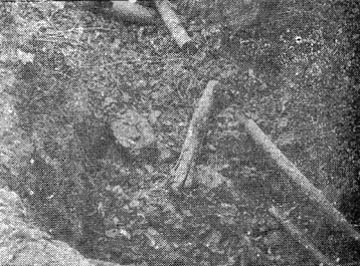 |
| OBJECTIVE - Vietnam is dotted with Viet Cong tunnels such as this one, found on a recent search-and-destroy operation near the Ho Bo Woods. (Photos by Vickery) | DESTRUCTION - Sergeant Charles Tantype Jr., of St. Louis, Ill., a member of 65th Engineer Battalion, prepares plastic explosive to blow tunnel. | WHAT'S LEFT - This is the remains of the VC tunnel which was found by Company C, 4th Battalion, 23rd Infantry. |
The tunnel is the home, hiding place and warehouse for the Viet Cong.
Vietnam is dotted with tunnels, ranging from simple to elaborate, some extending
to five levels.
Networks of tunnels often run for several miles, with the larger ones
containing storage rooms, kitchens, meeting rooms, lavatories and sleeping
quarters.
From a tunnel, the VC can strike an American camp, fight until the battle
turns against him, then slip back into his hole, safe from bombs and artillery.
Some or these tunnels are more than a half century old. To eliminate the VC,
military forces must destroy these tunnels.
When the division arrived at Cu Chi, soldiers were often hit by sporadic
sniper fire. The sniper would slip from his tunnel, fire a burst from his
rifle, then scurry back into his hole, safe from returning fire.
Units checked the entire base camp and as they found tunnels, they buried
them. In all they destroyed more than 400 tunnels within the perimeter of the
base camp, an area of less than two square miles.
After the camp was secure, the division began clear-and-destroy operations to
eliminate Viet Cong resistance. They lined up in sweep formations, ready to
fight, but they found that the enemy used a different rule book.
The VC avoided heavy contact. They set numerous mines and booby traps or
struck from a tunnel and then disappeared before their positions could be
spotted.
To cope with the problem, the division assigned demolition teams from the
65th Engineer Battalion to join the infantry on operation. The engineers
carried dynamite and a high-powered plastic explosive.
When the infantry found a tunnel, the "demo" team would disarm the usual
booby trap at the entrance, and then blow it. To assist in finding all of the
well-hidden tunnel entrances, the division employed the "Mighty Mite," a small,
portable motor that pumps harmless smoke into the tunnel.
The smoke circulates through the tunnel and escapes through all the openings,
revealing the hidden entrances.
This method of destroying tunnels was effective around the base camp, but as
operations spread to new areas it began losing its effect. Explosives would not
completely destroy the tunnels. All the method did was close the entrance.
To restore the tunnel, the enemy just cleared the old entrance or dug a new
one. Near the base camp this would be suicide, but out of sight of the
Americans they would reclaim "blown" tunnels.
Now the Army has found a way to eliminate these tunnels completely, and the
division is using it.
Explosives are still used for destroying the smaller tunnels but for the
larger ones, a vaporized explosive is used. To employ this method, the demo
teams first use the Mighty Mite, find all the entrances and seal shut all except
the two farthest apart.
Again using tile Mighty Mite, they pump the explosive into the tunnel instead
of smoke. When the explosive circulates from one entrance to the other, it is
ignited. The result is a long scar where the tunnel used to be and some VC
guerrillas with a big digging project ahead of them.
Lt. Larry Connors Big Hero In The Battle Of 10 Alfa
Call it what you want - courage, bravery, heroism or just plain guts - 2nd
Lieutenant Larry Connors has it.
Lt. Connors is the leader of the third platoon of Company A, 1st Battalion,
35th Infantry. He has only been with them a month but in that time he made his
mark.
It was on May 29 that Lt. Connors swung into action. His company and another
were in the midst of a North Vietnamese Army (NVA) "hornet's nest" at a landing
zone known as 10 Alpha.
Facing the two companies was an NVA regiment, spraying a constant curtain of
lead above the soldiers' heads. Lt. Connors' men were taking their share of
wounds.
Noticing some of his wounded men were in exposed positions and had to be
carried to safety, the lieutenant darted in front of his platoon's line of fire
to bring the men back.
After the NVA soldiers broke contact, Lt. Connors' platoon was searching the
battle area when suddenly a communist machine gun opened fire, pinning down the
platoon. The only way out was to knock out the machine gun.
He tried working his way around the emplacement, only to be wounded in the
head. His company commander, Captain Anthony Bisantz, urged the lieutenant to
"stay put" until the medical evacuation choppers could get him.
Lt. Connors decided to go back to his platoon anyway. With blood streaming
down his face, he continued to lead his men against the NVA.
Moments after the platoon leader had rejoined his men, an NVA soldier popped
up in the chest-high saw grass and lobbed a hand grenade at the American.
Though the grenade exploded only a few feet from him Lt. Connors escaped
injury.
Lt. Connors was more enraged than shocked. He shouted and threw a grenade
back. The NVA soldier paid with his life.
The battle raged on and others of the lieutenant's men were being hit. The
platoon sergeant was seriously wounded and the lieutenant ran to him and stayed
until the medic arrived to help.
Finally Capt. Bisantz got Lt. Connors on a med-evac helicopter. But the
moment the captain had turned away, Lt. Connors jumped off and tried to go back
to his men. The captain had to get some men to put Lt. Connors on the chopper
forcibly. This time he stayed.
Lt. Connors was evacuated to the hospital at Qui Nhon where doctors found
another wound in the lieutenant's side, one he hadn't mentioned. The doctors
say he will be, all right.
Sergeant Noble Hyde, a squad leader in Lt. Connors, platoon, spoke for the
rest of the men. "He stayed with us all the time. We couldn't have had a
better platoon leader. He acted like a combat veteran."
3/4 Cav., ARVN Train On Methods, Techniques
The 3rd Squadron, 4th Cavalry, has teamed with the Army, Republic of Viet
Nam's (ARVN) 25th Reconnaissance Company in another step on the trail to
operation unity between the two allies.
During a 30-day period, the two units will work in close company, exchanging
information on each other's methods and techniques.
The 3/4 Cav. will train the ARVN troops in air mobile operations,
intelligence, demolition, scouting, map reading and operation of weapons.
Instruction will be given on everything from small-unit tactics to large unit
operation. More than five interpreters will be used to break the language
barrier for the 100 ARVN soldiers.
Major Albert L. Russell, Havertown, Pa. Acting squadron commander said, "We
will benefit from them as much as they from us. This joint venture will give us
closer ties and an appreciation of each other's tactics."
Captured Cong Leads U.S. To Enemy Tunnel
A Viet Cong platoon leader, so frightened that he sent his wife with the
message that he would surrender, led American units to nine other VC during the
division's Operation "Fresno."
After he was captured, the platoon leader led the U.S. troops to a tunnel,
which he said contained other Viet Cong. The soldiers tossed a red smoke
grenade in the entrance and waited for the VC to come out.
Moments later, nine VC came stumbling out of the tunnel, coughing and covered
with red mist from the smoke grenade. They were returned to the camp and turned
over to Vietnamese intelligence officers.
One of the nine was a finance cadre and the remainder were Viet Cong
soldiers, the Vietnamese reported.
The platoon leader's wife' was taken to the base camp. All of the family's
possessions, including the cattle, were brought with them.
The platoon leader will probably resettle with his family in one of the
government's "New Life" hamlets
Pilot Cost
Pilot training costs about $250,000 for each jet pilot, $110,000 for
propeller aircraft pilots and $15,000 for helicopter pilots. This does not
include depreciation of facilities and investment in aircraft. Pilot training
is, by far, the most time-consuming and costly of the Defense Department's
in-house training. Costs approach 81 billion annually.
(AFNB)
Watts Brothers Meet At Cu Chi
Three brothers, representing the engineer, armor and artillery branches of
the Army, held an unofficial family reunion recently at Cu Chi.
Major Jim H. Watts, a member of Company A, 25th Aviation Battalion, greeted
his two brothers, Captain C.D. Watts, of the Military Assistance
Command, Vietnam Advisory Team 57 at Tra On, and 1st Lieutenant R.P. Watts, Army
Headquarters Command in Saigon.
Page 7 TROPIC LIGHTNING NEWS July 15, 1966
Xmas In July
Gifts Flood Ilikai East
Visitors at the Ilikai East, the division's enlisted men's club, have been on
the receiving end of an avalanche of gifts that have made the club look like
Christmas in July.
Contributed by generous individuals and groups from the United States, the
goodies include thousands of free cigarettes passed out over the counter.
These cigarettes are obtained by donors through the tobacco companies which
include a message in the packaging naming the donor.
Some of the cigarettes come directly by mail from the U.S., but the majority
are picked up at the Saigon U.S.O. by First Lieutenant James A. Breedlove, of
Athens, Ga., a member of the division G-I sections.
Lt. Breedlove travels the 20 miles to Saigon with a jeep and trailer once
every two weeks to pick up cigarettes, cookies, books and letters for "Tropic
Lightning" soldiers.
Lt. Breedlove has noticed that the donations seem almost localized. Most of
the cigarettes come from the Midwest and from the tobacco country of the
southeastern United States. The bakers seem to be from the Northeast and the
far West. The lieutenant has personally seen 10 to 15 boxes of cookies sent by
one woman.
Cases of cigarettes have come from the Danville Optimists Club and the local
Veterans of Foreign Wars, of Danville, Va.; Coble Farm and Equipment Company, of
Burlington, N.C.; the Southern Deposit Bank, of Russellville, Ky.; the Printers
Bank and Trust of Catham, Va.; and "a friend." One case also contained the
message "Good luck and Godspeed" from Dan McShea's Rustic Tavern, of Cherry
Hill, N.J.
The cigarette manufacturers provide cards in each carton for recipients to
send their thanks.
4/9th Hits In Water Operation
Aquatic warfare and the Navy are usually synonymous.
Not so last week as the 4th Battalion, 9th Infantry, reconnaissance platoon
was assigned to search and destroy enemy positions along the Suoi Muong River,
north of Cu Chi.
The platoon boarded two boats waiting for them at "Ann-Margret" Bridge at the
far edge of the perimeter. Platoon Leader 1st Lieutenant Charles R. Scott, of
Rockford, Ill., gave his men last-minute instructions on how to leave the boats
should they come under fire.
Though the boats were equipped with outboard motors, the recon platoon rowed
down the river, trying not to alert the Viet Cong.
The river, narrow and shallow in many places, made it difficult to maneuver
the fairly large boats. At times, the craft sailed under low, overhanging trees
and shrubs, knocking large spiders and red ants into the boats.
The men found camouflaged bamboo houses apparently used by the Viet Cong to
snipe at patrols leaving the base camp.
Also found were several fishing sites and one large net. During their
voyage, the recon platoon destroyed several small sampans used by the VC to
transport supplies.
|
Land And Run |
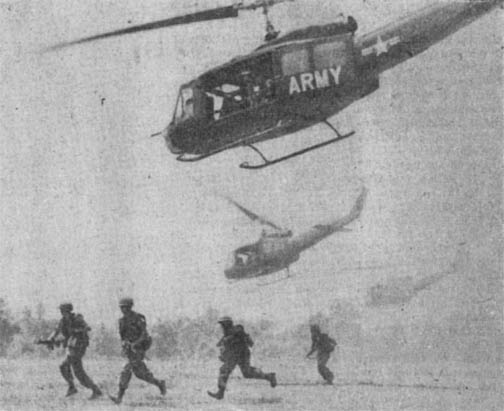 |
| Division members run for cover after being airlifted into a rice paddy. Action took place during the recent Operation "Fort Smith." |
Lights Search Cu Chi Perimeter
Guards in support command bunkers at Cu Chi need to be in the dark no longer.
Six bunkers on the southern perimeter now have search lights. The lights,
helicopter search lights powered by two truck batteries, were fabricated by
Staff Sergeant Erwin A. Martin, Aberdeen, Me. The head of the field and
engineer section of Shop A, 725th Maintenance Battalion, said the lights are
ideal.
"The lights can be run continuously all through the night and the batteries
can be recharged during the day," Sgt. Martin said. "The truck batteries are an
excellent power source."
Major James N. Presley, Memphis, Tenn., assistant division logistics officer,
said the lights were temporarily installed until larger Xenon tower lights are
made available.
They are being used to scan the perimeter at night and are effective to 100
yards.
| CAME THE DAWN - Major General Fred C. Weyand, division commander, listens to Major Ronald C. Vines, aircraft commander, explain the uses of the 1,750,000 candle power lighting system. (Photo by Earl) |
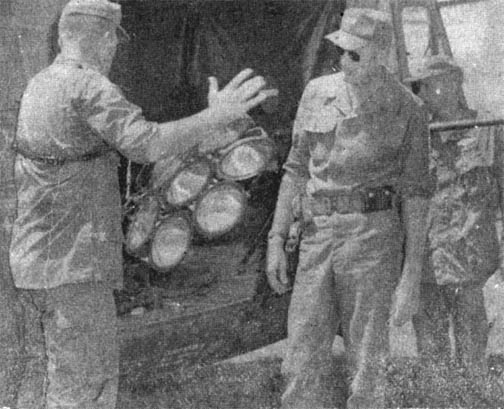 |
Personnel Actions Handles Passports
Malaysia, Singapore and Thailand require passports from members of the armed
forces on leave from Vietnam.
The Personnel Actions Branch is responsible for providing forms and
assistance and liaison with the American Embassy in Saigon to obtain passports
for division members.
The 125th Signal Battalion will provide passport pictures from 1 p.m. to 3
p.m., Tuesdays and Thursdays, at the Personnel Actions Branch.
No passport is required for Hong Kong, Japan, Okinawa, Taiwan and the
Philippines for personnel traveling in military clothing.
Rest and recuperation personnel do not need passports.
Members of U.S. armed forces taking ordinary leave in countries authorized
for ordinary leave must comply with entry and exit regulations. Personnel will
not be allowed to depart on ordinary leave to the below listed countries until
they have complied with the appropriate passport and visa requirements.
| DESTINATION | TRANS | CLOTHING | PASSPORT | VISA |
| Hong Kong | Com or Mil | Mil | No | No (1) |
| Com or Mil | Civ | Yes | No (1) | |
| Japan | Com or Mil | Mil or Civ | No | No |
| Malaysia | Com or Mil | Mil or Civ | Yes | No |
| (Penang & Kuala Lumpur) | ||||
| Okinawa | Com or Mil | Mil or Civ | No | No |
| Philippines | Com or Mil | Mil or Civ | No (2) | Yes (3) |
| Singapore | Com or Mil | Mil or Civ | Yes | No |
| Thailand | Com | Mil or Civ | Yes | No |
| Mil | Mil | Yes | No | |
| Taiwan | Com | Civ | Yes | Yes |
| Mil | Mil | No | No |
| (1) If leave is in excess of 14 days, visa is required. |
| (2) For personnel on ordinary leave going to the Philippines, the Consular
Section will issue a letter of introduction in lieu of a passport. The letter
of introduction can be presented to the Philippines Embassy for necessary visa.
Only R&R personnel can enter the Philippines without a letter of introduction or
passport. This provision includes Philippine nationals in U S. armed forces. |
| (3) Philippine visa information may be obtained at Personnel Actions (Lightning
102). |
Page 8 TROPIC LIGHTNING NEWS July 15, 1966
Ambush Flops
Charlie's Threat Gets 'You-Lose' U.S. Scoff
Viet Cong threats to eliminate a division Medical Civic Action Program (MEDCAP)
team operating in southern Hau Nghia Province were not without basis, but an
attempted ambush by command-detonated mine was unsuccessful.
Working in the hamlets of Tan My, Hiep Hoa, Duc Hue and So Do, the 2nd
Battalion, 27th Infantry, medics were making friends for the American soldiers
and the Vietnamese government.
This evidently rankled the local Viet Cong.
Shortly after the medics began operating in the area, the villagers in Tan My
reported that the VC had threatened to kill the members of the team. One
citizen said the communists had told him that the American doctors were not
giving them medicine, but "poison pills" instead.
Army of the Republic of Vietnam units in the area beat off two VC attempts to
mine the route taken by the medics into Tan My, but were unaware of the ambush
planned on the outskirts of Hiep Hoa, two miles away.
A 10-pound command-detonated mine was set off as the "Wolfhound" ambulance
roared down the road with two gun jeeps.
"The VC," said one medic, "didn't expect us to be doing 40 miles an hour, and
the mine missed us."
For their aggressive MEDCAP program. "Wolfhound" infantrymen have nicknamed
the medics "Monroe's Marauders," after the battalion surgeon, Captain William
Monroe, of Chapel Hill, N.C.
In the three weeks following the beginning of concentrated MEDCAP action on
June 13, the Marauder team has treated over 3,000 civilians.
| Wounded VC suspect is unloaded from a helicopter by PFCs Cole and Delbert J. Fry,: of Yuba City. Calif., as Major John W. Loffert (far left) operations officer, 2nd Battalion, 27th Infantry, looks on. The action took place during the recent Operation "Fresno" conducted 30 miles northwest of Saigon. (Photo by Seely) |
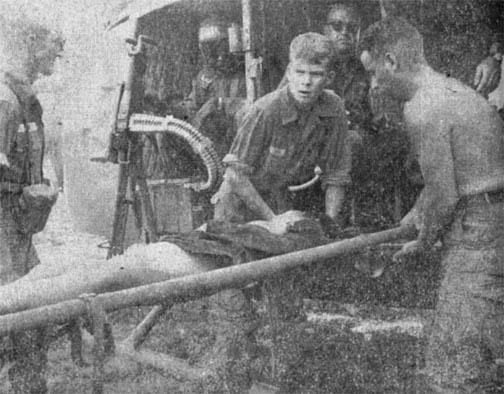 |
Wolfhounds Hit VC Foxholes
Company A, 1st Battalion, 27th Infantry, discovered 41 Viet Cong foxholes
only a mile west of the division's base camp on an area sweep.
The holes were found in two locations about 500 yards apart. The first
location revealed 34 holes that were not dug in any set pattern. They were
about three feet deep and extended a few feet to either side of the opening.
Captain Lowell J. Mayone, of Saugerties, N.Y., company commander, said the
holes were a week to ten days old. "It looked as if the VC spent a night and a
day in the area and dug in just in case," Capt. Mayone said.
Interpreters Make Life Easy
There is a group of Vietnamese soldiers attached to the division which is
extremely valuable, but receives very little credit. The people of this group
are invaluable to the commanders of every unit . . . sometimes down to squad
level. They are the key to a successful Medical Civic Action Program (MEDCAP)
or a high level conference between Vietnamese and U.S. forces leaders. They
are, of course, the interpreters attached to the division.
Staff Sergeant Nguyen Duy Tuan typifies the average Vietnamese interpreter.
Tuan is 5 feet 3 inches tall. carries a carbine rifle, speaks almost perfect
English, and has a smile for everyone.
He was drafted into the Army of the Republic of Viet Nam (ARVN) about five
months ago and spent the first part of his army career attending language and
noncommissioned officers schools in Saigon. Upon completion of school Sergeant
Tuan was assigned to 1st Brigade Headquarters.
Sergeant Tuan, like most of the 25th's interpreters, leads a varied and
interesting life. When a Vietnamese official visits the 1st Brigade he is
called upon to interpret for Colonel William Sandlin Jr., the 1st Brigade's
commander.
On MEDCAPs, Sergeant Tuan not only acts as an interpreter but also as a medic
and an MP on the side. He must be extremely accurate when he interprets a
patient's ailments to the doctor and, in turn, interpret the doctor's advice and
directions for taking the medicine to the patient so that he understands without
question what to do.
When called upon on field operations, Sergeant Tuan interrogates captured
Viet Cong prisoners, questions villagers about VC activities and booby traps,
and translates written messages and documents left behind by, or captured from,
the Viet Cong.
More than just an interpreter, Sergeant Tuan is a teacher and diplomat as
well. During the day he furthers the understanding of the Vietnamese people
about what the United States is trying to accomplish in Vietnam, and what the
25th Infantry Division is trying to accomplish in their immediate area. At
night, Sergeant Tuan helps the men of the 1st Brigade understand his people,
their - customs, habits and their colorful culture.
Paper Tattles
Med Supplies Low, Viet Cong Complain
A document found in a Viet Cong hospital near the Cambodian border on July 9
indicated the VC in this area are critically short of medical supplies.
Company A, 1st Battalion. 27th Infantry, swept an area about 27 miles
southwest of Cu Chi last week, finding VC training aids and medical documents
saying they were in need of supply.
The documents, according to an Army, Republic of Vietnam, interpreter, said
the VC were in urgent need of morphine. Sterilized handbags, clothes, beds and
pamphlets were also found.
Before coming upon the hospital the "Wolfhounds" received sniper fire. They
found the cache while looking for the sniper.
Also found was a clay model of a "Huey" helicopter. The model was so
complete it showed the turbine engine and the propellers were operational. It
is believed to be a training aid to show the VC where to hit a chopper to shoot
it down.
The "Wolfhounds," searching further in the area, just a mile from the
Cambodian border, found almost 6,000 pounds of rice and destroyed 13 structures.
Thanks to:
The 25th Infantry Division Museum for providing the volume of 1966 Tropic
Lightning News,
Ron Leonard, 25th Aviation Battalion for finding and mailing them,
Kirk Ramsey, 2nd Bn., 14th Inf. for creating this page.
This page last modified
08-08-2007
©2007 25th Infantry Division Association. All rights reserved.